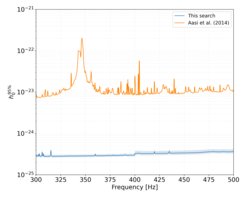Searching for continuous waves from neutron stars in binaries
Unique search on Advanced LIGO data excludes unexplored binary neutron star configurations
Rapidly rotating deformed neutron stars in binary systems are a promising yet difficult-to-find source of continuous gravitational waves. Researchers from the permanent independent research group “Continuous Gravitational Waves” at the Max Planck Institute for Gravitational Physics in Hannover now have published a unique analysis of public LIGO O3a data. They searched for continuous gravitational-wave signals with frequencies between 300 and 500 Hertz emitted by neutron stars in binary systems with orbital periods between half a month and two months. This is the only binary search in this frequency region. While no signals are found, the search is much more sensitive (by a factor of >10) than previous analyses and therefore excludes plausible and unexplored binary neutron star configurations in our Galaxy.
Paper abstract

Continuous gravitational waves are nearly monochromatic signals emitted by asymmetries in rotating neutron stars. These signals have not yet been detected. Deep all-sky searches for continuous gravitational waves from isolated neutron stars require significant computational expense. Deep searches for neutron stars in binary systems are even more expensive, but these targets are potentially more promising emitters, especially in the hundreds of Hertz region, where ground-based gravitational-wave detectors are most sensitive. We present here an all-sky search for continuous signals with frequency between 300 and 500 Hz, from neutron stars in binary systems with orbital periods between 15 and 60 days and projected semimajor axes between 10 and 40 lt-s. This is the only binary search on Advanced LIGO data that probes this frequency range. Compared to previous results, our search is over an order of magnitude more sensitive. We do not detect any signals, but our results exclude plausible and unexplored neutron star configurations, for example, neutron stars with relative deformations greater than 3 × 10−6 within 1 kpc from Earth and r-mode emission at the level of α ∼ a few 10−4 within the same distance.












